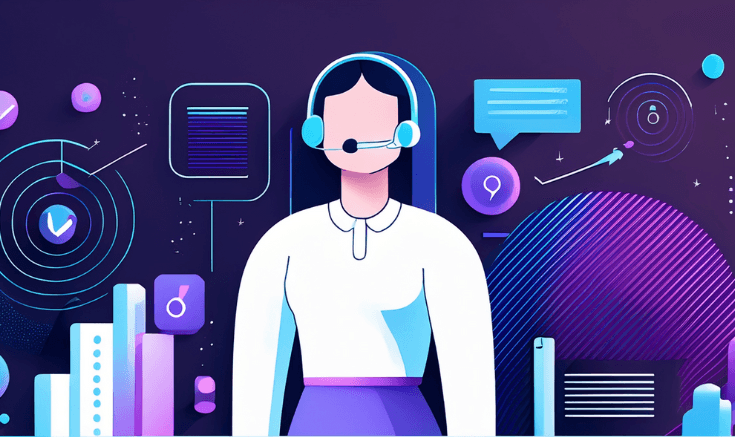

Enhancing customer experience with AI built for humans
APR. 26, 2025
4 Min Read
Customer relationships often hinge on speed, relevance, and genuine consideration for each person's expectations.
Many platforms now incorporate AI to address these needs, yet some solutions overlook the value of human empathy. Implementations that focus on user-centric design and thoughtful automation bridge that gap. Leaders who emphasize this alignment discover fresh opportunities for growth, retention, and meaningful interactions.
key-takeaways
- 1. Empathy remains a cornerstone even in automated systems, ensuring customers feel valued.
- 2. Careful data handling and consistent workflows influence how reliable AI recommendations become.
- 3. Predictive customer experience with AI helps teams anticipate needs and offer tailored responses.
- 4. Blended support models allow instant answers for simple questions and personal attention for complex issues.
- 5. Well-planned measurement identifies what works, guiding improvements that bring long-term gains.
What is AI built for humans?

AI built for humans focuses on creating solutions that prioritize empathy, user-centric design, and intuitive experiences. It ensures that machine learning insights are tailored to human needs, rather than forcing customers to adapt to rigid interfaces. Many organizations see artificial intelligence as a tool for efficiency, yet it can also strengthen interactions through natural language understanding. This approach fosters a welcoming space where customers feel valued and respected.
Developers and business leaders who follow this perspective emphasize personalization and clarity at every stage. They recognize the importance of language models and automation working seamlessly with human-centered standards. This synergy allows customer requests to be answered quickly, reducing friction and waiting times. It also encourages sustainable, scalable growth that aligns with cost-effectiveness and consistent user satisfaction. When this perspective meets the concept of customer experience with AI built for humans, organizations deliver solutions that resonate on a deeper level.
“Many organizations see artificial intelligence as a tool for efficiency, yet it can also strengthen interactions through natural language understanding.”
Benefits of integrating AI into customer experience
Many teams embrace artificial intelligence to deliver unique moments of delight, but they also want to ensure positive returns on their investment. Leaders often focus on key metrics such as response time, personalization, and operational efficiency. Careful planning around AI-based tools adds speed to business processes while reducing overhead. It promotes a scalable structure for introducing new solutions that keep up with shifting consumer preferences.
- Better personalization: AI-led analysis can tailor recommendations based on past purchases, browsing history, or interaction patterns. This customization fosters a sense of care and attention.
- Reduced wait times: Automated chat interfaces offer prompt responses, lowering frustration and improving satisfaction. Many organizations achieve these results with conversational AI for customer experience built around user needs.
- Cross-platform consistency: AI solutions can maintain the same user data across multiple channels, including web, mobile, and store-based interactions. This consistency assures customers that their preferences and history remain recognized at every touchpoint.
- Enhanced resource allocation: Teams can assign human agents to complex or sensitive requests while AI handles routine tasks. This approach optimizes operational costs, freeing skilled staff for high-impact engagements.
- Accuracy in recommendations: Advanced models can process large amounts of data, highlighting relevant products or services for each customer. These suggestions often lead to higher sales and elevated loyalty.
- Real-time insights: AI allows quick analysis of user interactions, alerting leaders to spikes in inquiries or potential issues. Swift action based on these insights helps maintain trust and reduces long-term costs.
The advantages listed above are most effective when accompanied by structured support and user-focused design. Clear communication ensures that automation works hand in hand with empathy, rather than replacing it. Consistency across channels also encourages loyalty, shaping a positive image of the brand. The next step involves seeing how real scenarios bring these benefits to life in different industries.
Examples of customer experience with AI built for humans

Organizations seeking practical innovation often look to real implementations of AI that put user comfort first. It could be as simple as a chatbot for basic inquiries or as robust as an analytics platform for personalized promotions. The key is designing each feature around genuine human preferences. This approach leads to stronger engagement, increased sales, and a smoother overall journey.
Seamless on-site support for retail
Some retailers use intelligent recommendation engines that learn from shoppers' browsing patterns and purchase histories. These engines may offer product suggestions based on style, size, or budget, minimizing guesswork. When integrated with loyalty programs, the system recognizes returning shoppers and tailors promotions to match their past activities. The result is a sense of familiarity that encourages repeat visits and larger cart sizes.
Conversational AI for customer experience in financial services
Banks and credit unions often deal with high volumes of queries, ranging from basic account details to transaction checks. An AI interface that responds accurately to such requests can reduce pressure on phone lines and in-branch visits. Natural language processing creates a more human-like dialogue, establishing a sense of understanding even in automated settings. This tactic preserves staff capacity for urgent matters while maintaining consistent service for everyone.
Strategies for balancing AI automation with human empathy

Teams often weigh the value of automation against the importance of genuine human connection. The objective is to boost efficiency without sacrificing emotional intelligence. Some tasks benefit from instant responses and real-time status updates, while others require sensitive judgment. Striking the right balance ensures that customers feel recognized, not processed like a ticket number.
Adopting a blended approach to support
An effective system channels routine inquiries to AI while routing intricate concerns to human agents. This allocation cuts down on wait times for simpler tasks, giving customers quicker answers. Meanwhile, staff can dedicate their expertise to issues that demand deeper insight. The blend of automation and empathy leaves people feeling respected, even when technology is involved.
Training teams for AI-human synergy
Success relies on training employees to work smoothly with AI outputs, rather than seeing them as isolated tools. Clear guidelines help staff understand when to override an automated recommendation, ensuring human discretion where needed. This process also reduces the likelihood of miscommunication, since employees know how to interpret AI alerts and customer queries together. Encouraging an open mindset cultivates trust both internally and externally.
Challenges in implementing AI for customer experience
Many organizations face challenges when implementing AI, especially in areas that involve direct interactions. Some worry about data quality or privacy, while others struggle to integrate AI outputs into existing workflows. A strong integration strategy can address these risks, but it requires proper planning. Even the most promising ideas can stall if teams fail to tackle common obstacles.
- Data accuracy: Incorrect or incomplete information can lead to wrong recommendations, damaging customer trust. Maintaining clean data pipelines is vital for reliable outcomes.
- Privacy concerns: Customers expect secure handling of personal details, so encryption and careful access management matter. Failing to protect data can undermine brand reputation.
- Organizational alignment: Introducing AI into established processes may disrupt typical workflows. Gaining buy-in from various stakeholders helps reduce resistance.
- Scalability issues: Some solutions perform well at smaller volumes but struggle when user traffic spikes. Proper testing ensures the system remains reliable under higher loads.
- Lack of human oversight: Over-reliance on algorithms can alienate users or overlook nuanced factors. Routine checks and well-defined escalation paths ensure empathy stays intact.
- Skill gaps: Staff may lack training to interpret AI insights or optimize its features. Continuous learning programs equip teams to maximize value from new tools.
Addressing these factors early improves the odds of successful deployment and customer satisfaction. Each challenge presents an opportunity to refine workflows, strengthen data handling, and foster collaboration. A proactive stance on these concerns not only protects reputations but also leads to more thoughtful innovation. Incorporating predictive analytics adds another layer of flexibility that can help teams avoid blind spots.
Leveraging predictive analytics for proactive customer engagement

Predictive analytics relies on historical data and advanced algorithms to forecast future behaviors. Many organizations see this as an essential tactic for strengthening relationships and boosting revenue. Accurate insights enable teams to adjust marketing strategies, plan inventory, and respond to shifting trends. When applied to customer experience with AI built for humans, predictive modeling provides personalized touchpoints before an issue arises.
Identifying patterns for tailored campaigns
Sales teams use predictive models to spot patterns in purchasing cycles and seasonal demand. This knowledge allows for timely campaigns that resonate with current preferences, improving conversion rates. Marketers can then send tailored messages to each segment, avoiding generic promotions. Customers feel acknowledged as distinct individuals rather than one-size-fits-all shoppers.
Predictive customer experience with AI in support services
Support centers benefit from accurate forecasts of ticket volumes and types of inquiries. AI can sort potential problems into categories for faster resolution, saving time for both customers and agents. Predictive signals also highlight potential escalations, prompting managers to schedule extra staff if a surge seems imminent. This method aligns well with a commitment to empathy and efficiency, resulting in more positive experiences.
“Accurate insights enable teams to adjust marketing strategies, plan inventory, and respond to shifting trends.”
Measuring the impact of AI on customer experience

Quantifying success starts with choosing the right metrics. Organizations often rely on satisfaction scores, churn rates, and average handling times to gauge effectiveness. Analytics tools, combined with feedback loops, help leaders see where AI interventions perform well and where they need refinement. This clarity uncovers gaps that can be resolved with focused improvements.
Tracking revenue growth or cost savings over time offers a clear view of return on investment. Some prefer a direct correlation between AI usage and specific business goals, such as expanding into new markets or releasing specialized offers. These insights guide future decisions about feature upgrades or system integrations. Detailed reporting also reassures stakeholders that resources are being used wisely, leading to more confident strategies.
Customer experience with AI built for humans is a gateway to more empathetic, efficient, and sustainable service delivery. Unlocking data-backed insights and personalized user journeys empowers organizations to focus on what truly matters: driving results. At Lumenalta, we specialize in building tailored solutions that align with your business goals, ensuring you’re equipped to lead. Let’s chart a brighter path together.
table-of-contents
- What is AI built for humans?
- Benefits of integrating AI into customer experience
- Examples of customer experience with AI built for humans
- Strategies for balancing AI automation with human empathy
- Challenges in implementing AI for customer experience
- Leveraging predictive analytics for proactive customer engagemen
- Measuring the impact of AI on customer experience
- Common questions about customer experience with AI built for humans
Common questions about customer experience with AI built for humans
How does an AI solution impact day-to-day operations?
What is the difference between conversational AI for customer experience and traditional automation?
How can predictive customer experience with AI improve loyalty?
Are there risks in adopting customer experience with AI built for humans?
What metrics are most important when evaluating AI performance?
Want to learn how artificial intelligence can bring more transparency and trust to your operations?







